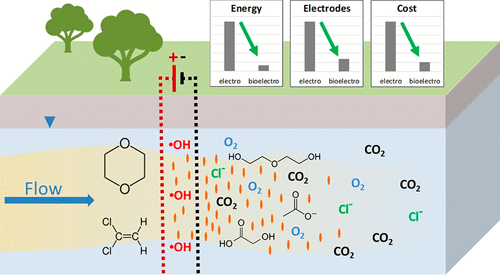当前位置:
X-MOL 学术
›
ACS Sustain. Chem. Eng.
›
论文详情
Our official English website, www.x-mol.net, welcomes your
feedback! (Note: you will need to create a separate account there.)
Bioelectrochemical Treatment of 1,4-Dioxane in the Presence of Chlorinated Solvents: Design, Process, and Sustainability Considerations
ACS Sustainable Chemistry & Engineering ( IF 7.1 ) Pub Date : 2021-02-12 , DOI: 10.1021/acssuschemeng.0c08152 Nasim E. Pica 1 , Yu Miao 2 , Nicholas W. Johnson 2 , Pia Ramos 2 , Shaily Mahendra 2 , Jens Blotevogel 1
ACS Sustainable Chemistry & Engineering ( IF 7.1 ) Pub Date : 2021-02-12 , DOI: 10.1021/acssuschemeng.0c08152 Nasim E. Pica 1 , Yu Miao 2 , Nicholas W. Johnson 2 , Pia Ramos 2 , Shaily Mahendra 2 , Jens Blotevogel 1
Affiliation

|
1,4-Dioxane is one of the most frequently detected organic water contaminants and often co-occurs with chlorinated volatile organic compounds due to its use as solvent stabilizer. Its recalcitrance challenges natural attenuation processes and conventional water treatment technologies. Here, we examined the bioelectrochemical oxidation of 1,4-dioxane using dimensionally stable mesh electrodes in flow-through reactors coupled with bioaugmentation by Pseudonocardia dioxanivorans CB1190. 1,4-Dioxane influent concentrations were rapidly reduced from 100000 μg/L by more than 4 orders of magnitude to below our detection limit of 3 μg/L. The application of an electric potential was associated with a higher abundance of P. dioxanivorans CB1190 in both sessile and planktonic states. The presence of 5 mg/L 1,1-dichloroethene, the strongest known chlorinated solvent inhibitor of 1,4-dioxane biodegradation, reduced 1,4-dioxane degradation rates by factors of 2–4 inspite of >99% electrochemical removal. In comparison with direct electrochemical 1,4-dioxane oxidation, the coupling with biological oxidation reduced energy consumption, material usage, and, consequently, overall treatment costs by about 1 order of magnitude while generating lower amounts of disinfection byproducts. Our results establish that bioelectrochemical treatment is a synergistic, sustainable technology for water contaminated with 1,4-dioxane and chlorinated co-contaminants to meet strict regulatory thresholds.
中文翻译:

在存在氯化溶剂的情况下对1,4-二恶烷进行生物电化学处理:设计,工艺和可持续性方面的考虑
1,4-二恶烷是最常检测到的有机水污染物之一,由于用作溶剂稳定剂,因此经常与氯化挥发性有机化合物共存。它的顽固性挑战自然衰减过程和常规水处理技术。在这里,我们检查了流通反应器中尺寸稳定的网状电极对1,4-二恶烷的生物电化学氧化作用,并通过伪拟心动二恶草酸CB1190进行了生物增强。1,4-二恶烷的进水浓度从100000μg/ L迅速降低了4个数量级以上,降至3μg/ L的检测极限以下。电势的施加与较高的二恶草拟南芥数量有关CB1190处于无柄和浮游状态。5 mg / L 1,1-二氯乙烯是已知的最强的1,4-二恶烷生物降解的氯化溶剂抑制剂,尽管电化学去除率> 99%,但由于2-4的影响,降低了1,4-二恶烷的降解速率。与直接电化学的1,4-二恶烷氧化相比,与生物氧化的结合减少了能源消耗,材料使用量,因此总体处理成本降低了大约1个数量级,同时产生了较少量的消毒副产物。我们的研究结果表明,生物电化学处理是一种协同,可持续的技术,用于处理被1,4-二恶烷和氯化共污染物污染的水,以满足严格的监管阈值。
更新日期:2021-03-01
中文翻译:

在存在氯化溶剂的情况下对1,4-二恶烷进行生物电化学处理:设计,工艺和可持续性方面的考虑
1,4-二恶烷是最常检测到的有机水污染物之一,由于用作溶剂稳定剂,因此经常与氯化挥发性有机化合物共存。它的顽固性挑战自然衰减过程和常规水处理技术。在这里,我们检查了流通反应器中尺寸稳定的网状电极对1,4-二恶烷的生物电化学氧化作用,并通过伪拟心动二恶草酸CB1190进行了生物增强。1,4-二恶烷的进水浓度从100000μg/ L迅速降低了4个数量级以上,降至3μg/ L的检测极限以下。电势的施加与较高的二恶草拟南芥数量有关CB1190处于无柄和浮游状态。5 mg / L 1,1-二氯乙烯是已知的最强的1,4-二恶烷生物降解的氯化溶剂抑制剂,尽管电化学去除率> 99%,但由于2-4的影响,降低了1,4-二恶烷的降解速率。与直接电化学的1,4-二恶烷氧化相比,与生物氧化的结合减少了能源消耗,材料使用量,因此总体处理成本降低了大约1个数量级,同时产生了较少量的消毒副产物。我们的研究结果表明,生物电化学处理是一种协同,可持续的技术,用于处理被1,4-二恶烷和氯化共污染物污染的水,以满足严格的监管阈值。









































 京公网安备 11010802027423号
京公网安备 11010802027423号